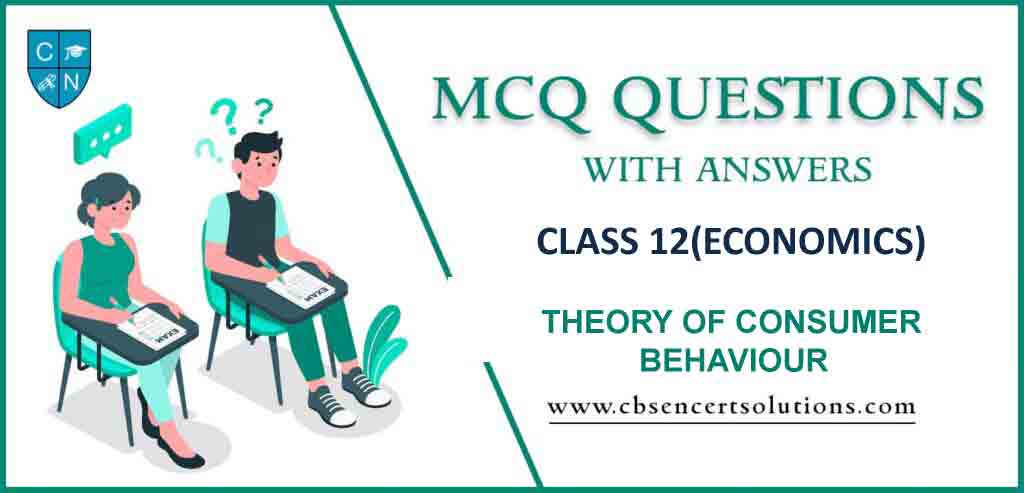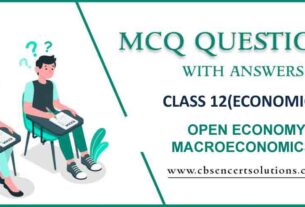Check the below NCERT MCQ Class 12 Economics Chapter 2 Theory of Consumer Behaviour with Answers available with PDF free download. MCQ Questions for Class 12 Economics with Answers were prepared based on the latest syllabus and examination pattern issued by CBSE, NCERT and KVS. Our teachers have provided below Theory of Consumer Behaviour Class 12 Economics MCQs Questions with answers which will help students to revise and get more marks in exams
Theory of Consumer Behaviour Class 12 Economics MCQ Questions with Answers
Refer below for MCQ Class 12 Economics Chapter 2 Theory of Consumer Behaviour with solutions. Solve questions and compare with the answers provided below
Question. Who gave the cardinal concept of utility?
(a) Marshall
(b) Pigou
(c) Hicks
(d) Samuelson
Answer
A
Question. Which of the following statement is true ?
(a) Utility means want-satisfying power
(b) Utility is a function of intensity of desire
(c) Desire of consumption gives birth to utility
(d) All of these
Answer
D
Question. Which of the following is a characteristic of utility ?
(a) Utility is a psychological phenomenon
(b) Utility is subjective
(c) Utility is a relative concept
(d) All of these
Answer
D
Question. When TU becomes maximum, MU is:
(a) Positive
(b) Negative
(c) Zero
(d) None of these
Answer
C
Question. Who basically propounded the concept of Law of Equimarginal Utility ?
(a) Marshall
(b) Gossen
(c) Ricardo
(d) J. S. Mill
Answer
C
Question. The ability of satisfying human want in a goods is called its:
(a) Productivity
(b) Satisfaction
(c) Utility
(d) Profitability
Answer
C
Question. Utility is related to:
(a) Usefulness
(b) Morality
(c) Satisfaction of human wants
(d) All the above
Answer
D
Question. Law of Equi-marginal utility is called:
(a) Law of increasing utility
(b) Law of diminishing utility
(c) Law of substitution
(d) None of these
Answer
C
Question. The addition of utilities obtained from all units of a goods is called :
(a) Marginal Utility
(b) Total Utility
(c) Maximum Satisfaction
(d) Additional Utility
Answer
B
Question. The propounder of law of diminishing marginal utility is:
(a) Gossen
(b) Adam smith
(c) Chapman
(d) Hicks
Answer
A
Question. The capability of a commodity to satisfy human wants is:
(a) Consumption
(b) Utility
(c) Quality
(d) Taste
Answer
B
Question. When marginal utility is negative, then total utility:
(a) is maximum
(b) Starts decreasing
(c) increases at decreasing rate
(d) None of these
Answer
B
Question. According to Marshall, utility of a commodity:
(a) Can be measured by money
(b) Cannot be measured by money
(c) Can be measured in cardinal numbers
(c) Both (a) and (b)
Answer
C
Question. Demand Curve generally slopes:
(a) Upward from left to right
(b) Downward from left to right
(c) Parallel to X-axis
(d) Parallel to Y-axis
Answer
B
Question. Which of the following factor affects demand ?
(a) Price
(b) Change in income
(c) Taste of the Consumer
(d) All of these
Answer
D
Question. When TU is maximum then MU is?
(a) Zero
(b) Negative
(c) Both
(d) None.
Answer
A
Question. When marginal utility from the consumption of a commodity is zero, then the:
(a) Total utility is zero
(b) Total utility is highest
(c) Total utility is rising
(d) Total utility is falling
Answer
B
Question. Which economist said that money is the measuring rod of utility?
(a) (a)C Pigou
(b) Alfred Marshall
(c) Adam Smith
(d) Robbins
Answer
B
Question. The law of equi marginal utility considers price of money as:
(a) Zero
(b) Less than one
(c) More than one
(d) One
Answer
D
Question. Marshallian utility analysis is known as ________.
(a) Cardinal
(b) Ordinal
(c) Classical
(d) Historical
Answer
A
Question. For the marketing manager, social class offers some insights into consumer behavior and is potentially useful as a ___________________.
(a) Market research information
(b) Market segmentation variable
(c) Source of understanding competition’s strategy
(d) Source to predict future trends
Answer
A
Question. The reason that higher prices may not affect consumer buying is _______________.
(a) Most consumers prefer brand names which have higher prices
(b) 70% of the total population looks for quality services and is willing to pay higher prices
(c) Consumers believe that higher prices indicate higher quality or prestige
(d) Most consumers feel that the price is actually affordable
Answer
A
Question. Secondary reference groups include ________________.
(a) Family and close friends
(b) Sports groups
(c) Ethnic and religious groups
(d) Fraternal organizations and professional associations.
Answer
C
Question. Indifference curves are
(a) Convex to Origin
(b) Concave
(c) Neither ‘a’ nor ‘b’
(d) None
Answer
A
Question. At equilibrium, the slope of the indifference curve is:
(a) Equal to the slope of budget line
(b) Greater than the slope of budget line
(c) Smaller than the slope of budget line
(d) None
Answer
A
Question. Indifference curves never intersect each other due to:
(a) Different levels of satisfaction
(b) Same levels of satisfaction
(c) Convex to origin
(d) Concave to origin
Answer
A
Question. Total utility is maximum when :
(a) Marginal utility is maximum
(b) Marginal utility is Zero
(c) Average utility is maximum
(d) Average utility is Zero
Answer
B
Question. A book “The Nature and significance of Economic Science” is written by:
(a) Alfred Marshal
(b) Lionel Robbins
(c) Samuelson
(d) Adam Smith
Answer
B
Question. Health is not wealth because it has no:
(a) Scarcity
(b) Utility
(c) Marketability
(d) None of these
Answer
C
Question. The law of equi-marginal utility is otherwise called as:
(a) Law of substitution
(b) Law of diminishing MU
(c) Law of negative returns
(d) None of these
Answer
A
Question. In case of perfectly elastic demand, demand curve becomes:
(a) Horizontal
(b) Vertical
(c) Downward sloping
(d) None of these
Answer
A
Question. In case of perfectly elastic demand, the value of Ed is:
(a) One
(b) Greater than one
(c) Less than one
(d) Infinite
Answer
D
Question. ———— is nothing but willingness of consumers to purchase products and services as per their taste, need and of course pocket.
(a) Consumer behavior
(b) Consumer interest
(c) Consumer attitude
(d) Consumer perception
Answer
B
Question. ________________ is one of the most basic influences on an individual’s needs, wants, and behaviour.
(a) Brand
(b) Culture
(c) Product
(d) Price
Answer
B
Question. _____________ (is) are transmitted through three basic organizations: the family, religious organizations, and educational institutions; and in today’s society, educational institutions are playing an increasingly greater role in this regar(d)
(a) Consumer feedback
(b) Marketing information systems
(c) Market share estimates
(d) Cultural values.
Answer
D
Question. Marketing managers should adapt the marketing mix to ___________________ and constantly monitor value changes and differences in both domestic and global markets.
(a) Sales strategies
(b) Marketing concepts
(c) Cultural values
(d) Brand images.
Answer
C
Question. Which of the following is the most valuable piece of information for determining the social class of your best friend’s parents?
(a) The number of years schooling that they had
(b) Their ethnic backgrounds
(c) Their combined annual income
(d) Their occupations
Answer
D
Question. _________________ refers to the buying behavior of final consumers.
(a) Consumer buyer behavior.
(b) Target market buying
(c) Market segment buying
(d) Business buying behavior
Answer
A
Question. The starting point in understanding how consumers respond to various marketing efforts the company might use is the:
(a) Lipinski model of buying behavior.
(b) Stimulus-response model of buyer behavior.
(c) Freudian model of buying behavior.
(d) Maslow’s model of life-cycle changes.
Answer
B
Question. Marketers are always trying to spot ____________ in order to discover new products that might be wante(d)
(a) opinion graphers
(b) dissonant groups
(c) cultural shifts
(d) benchmarks
Answer
C
Question. Relatively permanent and ordered divisions in a society whose members share similar values, interests, and behaviors are called__________
(a) Cultures.
(b) Subcultures.
(c) Social classes.
(d) Social factors.
Answer
C
Question. Even though buying roles in the family change constantly, the ___________ has traditionally been the main purchasing agent for the family.
(a) Wife
(b) husband
(c) teenage children
(d) grandparent
Answer
A
Question. A ______________ is a person’s pattern of living as expressed in his or her activities, interests, and opinions.
(a) role
(b) status
(c) position
(d) lifestyle
Answer
D
Question. The basic premise of the _____________ is that people’s possessions contribute to and reflect their identities; that is, “we are what we have.”
(a) lifestyle concept
(b) self-concept
(c) personality concept
(d) cognitive concept
Answer
B
Question. According to Maslow’s Hierarchy of Needs, the lowest order of needs are called:
(a) Self-actualization needs.
(b) Social needs.
(c) Safety needs.
(d) Physiological needs
Answer
D
Question. A ___________ is a strong internal stimulus that calls for action.
(a) Driv
(b) cue
(c) response
(d) perception
Answer
A
Question. ___________ puts people into a frame of mind of liking or disliking things, of moving toward or away from them.
(a) A rule
(b) An attitude.
(c) A belief
(d) A cue.
Answer
B
Question. The stage in the buyer decision process in which the consumer is aroused to search for more information is called____________
(a) Information search.
(b) Evaluation of alternatives
(c) Search for needs
(d) Perceptual search.
Answer
A
Question. With respect to post purchase behavior, the larger the gap between expectations and performance:
(a) The greater likelihood of re-purchase.
(b) The greater the customer’s dissatisfaction.
(c) The less likely the consumer will be influenced by advertising
(d) The less likely the consumer will need sales confirmation and support.
Answer
B
Question. All of the following are part of the adoption process that consumers may go through when considering an innovation EXCEPT:
(a) Awareness.
(b) Process.
(c) Interest.
(d) Trial.
Answer
B
Question. The demand for necessaries is:
(a) Elastic
(b) Inelastic
(c) Unitary elastic
(d) Perfectly elastic
Answer
B
Question. In case of perfectly elastic, demand curve is:
(a) Vertical
(b) Horizontal
(c) Downward sloping
(d) None of these
Answer
B
Question. The demand for commodity on which a consumer spends more percentage of his income is:
(a) More elastic
(b) Less elastic
(c) Unity
(d) None of these
Answer
A
Question. Several characteristics are especially important in influencing an innovation’s rate of adoption. _________ is the degree to which the innovation may be tried on a limited basis.
(a) Relative advantage
(b) Synchronization
(c) Compatibility
(d) Divisibility .
Answer
D
Question. The business marketer normally deals with _____________ than the consumer marketer does.
(a) far greater but smaller buyers
(b) far greater and larger buyers
(c) far fewer but far larger buyers
(d) far fewer and smaller buyers
Answer
C
Question. The place in the business buying behavior model where interpersonal and individual Influences might interact is called the__________
(a) Environment.
(b) Response.
(c) Stimuli.
(d) Buying center.
Answer
B
Question. Consumer Surplus is based on which concept?
(a) Diminishing Marginal Utility
(b) Law of Demand
(c) Indifference curve Approach
(d) None
Answer
A
Question. An indifference curve is always:
(a) Concave to the origin
(b) Convex to the origin
(c) L-shaped
(d) A vertical straight line
Answer
B
Question. When a firm buys a product or service for the first time, it is facing a _____________
(a) Habitual re buy situation.
(b) Straight re buy situation.
(c) Modified re buy situation.
(d) New task situation.
Answer
D
Question. The stage of the business buying process where the buyer describes the characteristics and quantity of the needed item is called ___________
(a) Problem recognition.
(b) General need description.
(c) Product specification.
(d) Proposal solicitation.
Answer
B
Question. Factors such as supplier reputation for repair and servicing capabilities are important criteria for evaluation at which stage in the business buying process?
(a) problem recognition
(b) supplier search
(c) supplier selection
(d) order-routine specification.
Answer
C
Question. What is the behaviour of TP, when MP becomes negative?
(a) TP increases at an increasing rate
(b) TP increases at diminishing rate
(c) TP is maximum
(d) TP decreases
Answer
D
Question. __________ measures the productivity of a factor input.
(a) Total product
(b) Average product
(c) Marginal product
(d) Returns to a factor
Answer
B
Question. If AP of one unit of a variable factor is 12 units and that of 2 units of the variable factor is 16 units, then the marginal product of 2nd unit of the variable factor is __________ .
(a) 28 units
(b) 20 units
(c) 4 units
(d) 44 units
Answer
B
Question. ____________, at any particular level of employment of an input, is the average of all marginal products up to that level.
(a) Total product
(b) Average product
(c) Marginal product
(d) Returns to a factor
Answer
B
Question. When the Average Product (AP) is maximum, the Marginal Product (MP) is:
(a) Equal to AP
(b) Less than AP
(c) More than AP
(d) Can be any one of the above
Answer
A
Question. What is the behaviour of AP when TP increases at decreasing rate?
(a) AP increases
(b) AP decreases
(c) AP may increase or decrease
(d) AP is constant
Answer
C
Question. __________ refers to change in output when only one input is changed, other inputs remaining unchanged.
(a) Total product
(b) Average product
(c) Marginal product
(d) Returns to a factor
Answer
D
Question. ____________ shows the pattern of change in total product when only one input is increased, other inputs remaining unchanged.
(a) Marginal product
(b) Average product
(c) Law of variable proportions
(d) Returns to a factor
Answer
C
Question. The marginal product curve in the input-output plane, looks like ____________ .
(a) a ‘U’ shaped curve
(b) an inverse ‘U’ shaped curve
(c) an inverse ‘S’ shaped curve
(d) an ‘S’ shaped curve
Answer
B
Question. Both AP and MP curves are generally ___________ .
(a) U-shaped
(b) Inversely U-shaped
(c) Rising
(d) Falling
Answer
B
Question. When average product increases, the marginal product is:
(a) Less than average product
(b) Equal to the average product
(c) More than average product
(d) None of these
Answer
C
Question. The average product curve in the input-output plane, will be __________.
(a) an ‘S’ shaped curve
(b) an inverse ‘S’ shaped curve
(c) a ‘U’ shaped curve
(d) an inverse ‘U’ shaped curve
Answer
D
Question. Which of the following statements accurately describe the relationship between AP and MP?
(a) AP rises when MP is above it and falls when MP is below it.
(b) MP intersects AP at its minimum point.
(c) AP an MP are always parallel to each other.
(d) AP is always rising when MP is falling and vice-versa.
Answer
A
Question. What is the shape of TP curve when MP falls and becomes negative?
Answer
When MP falls and becomes negative, TP declines (phase III of production). So, TP curve is downward sloping.
Question. Consumer is in equilibrium when:
(a) MUx = PUx
(b) MUx > PUx
(c) MUx < Px
(d) MUx ÷ Px
Answer
A
Question. How many tremendous curves can touch the budget line:
(a) One
(b) Two
(c) Several
(d) Depends on the basis of indifference maps.
Answer
A
Question. Any statement about the demand of an object is considered complete when it is mentioned in the following:
(a) Price of good
(b) Demand of good
(c) Time period
(d) All of the above.
Answer
D
Question. According to total outlay method, the demand of a good is sinelastic when:
(a) Price will fall with the increase in amount spent
(b) When price of good decreases and money spent decreases
(c) Expenditure remains the same, even if price falls
(d) Expenditure decreases with the increase in price.
Answer
B
Fill in the blanks:
Question. If the price of substitute goods increases then the demand curve shifts to the ………….
Answer: Right
Question. According to Marshall utility can be measured in terms of ………….
Answer: Money
Question. Car and Petrol are goods ………….
Answer: Substitute
State true or false:
Question. Utility is an intensive assumption.
Answer: True
Question. Demand curve is generally negative sloped.
Answer: False
Question. The elasticity of the demand of the object and the expenditure on the object is closely related.
Answer: True
Match the following:
| ‘A” | ‘B’ |
| 1. Inelastic | (a) Utility analysis |
| 2. Substitute goods | (b) Demand of Necessary or Essential goods |
| 3. Marshall | (c) Gossen’s second law |
| 4. Indifference curve | (d) Cross demand |
| 5. Law of equi marginal utility | (e) Does not cut each ether |
Answer:
| ‘A” | ‘B’ |
| 1. Inelastic | (b) Demand of Necessary or Essential goods |
| 2. Substitute goods | (d) Cross demand |
| 3. Marshall | (a) Utility analysis |
| 4. Indifference curve | (e) Does not cut each ether |
| 5. Law of equi marginal utility | (c) Gossen’s second law |

We hope you liked MCQ Class 12 Economics Chapter 2 Theory of Consumer Behaviour with answers provided above. Incase you have any questions relating to the above MCQ Questions please post them in the comments section below and our Economics teachers will provide a response.

